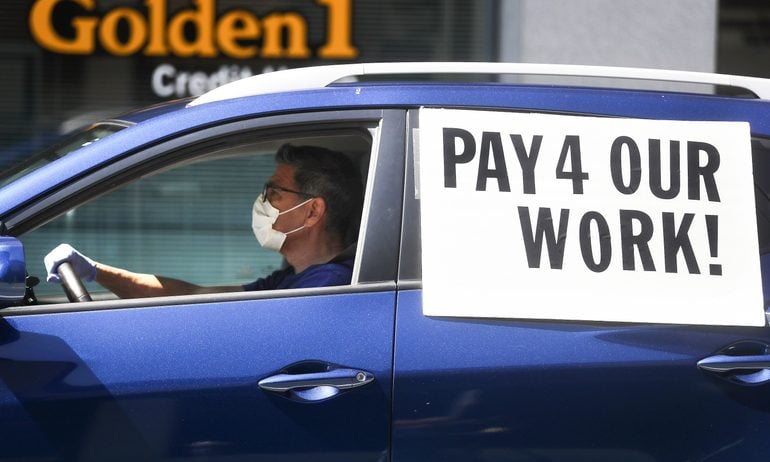Gig Workers Left High and Dry When It Comes to Benefits
A new study finds that independent workers often face financial instability.

Many, or all, of the products featured on this page are from our advertising partners who compensate us when you take certain actions on our website or click to take an action on their website. However, this does not influence our evaluations. Our opinions are our own. Here is a list of our partners and here's how we make money.
Everybody talks about the “gig economy,” but it’s notoriously hard to define or tally.
The Bureau of Labor Statistics, the official source of U.S. workforce statistics, “does not have a definition of the gig economy or gig workers,” it said in a 2019 blog post, and instead works to count up constituent categories like independent contractors, on-call workers, contingent and temporary workers and “electronically mediated workers” (i.e., those who find work though apps like Uber and DoorDash).
If there’s one theme that ties this diverse and growing segment of the labor force together, it’s a general lack of access to the kinds of benefits that many full-time employees take for granted, like health insurance, paid time off and retirement fund contributions.
“I would say the cracks are showing in our benefit system,” says Noah Lang, CEO of Stride, a company that provides tools to help independent workers manage health insurance, taxes, savings and other aspects of their financial lives.
Where gig workers fall short on benefits
Workers choose gig work for a wide range of reasons, some for lack of access to full-time jobs and others because they prefer the flexibility of independent work. Some work multiple gigs. No matter the impetus, Lang says, “there's all of this financial insecurity that comes along with it, just because these people are detached from the benefits system that's been built in this country.”
Stride conducted a survey with Mastercard, released this week, that found that 75% of independent workers surveyed do not receive any type of employer benefit contributions; 92% of them reported that they receive no health-specific health contributions.
Stride’s survey included independent “1099” workers (1099 is a tax form that shows nonwage income, common among independent workers) and some “W-2” workers who have formal employment but have little in the way of formal benefits. In total, 1,981 respondents were surveyed.
Among all respondents, these were the “most desired” benefits contributions:
Health insurance (28%).
Paid time off (27%).
Retirement savings (20%).
The lack of paid time off (PTO) and the unpredictability of income flow leads many in the gig economy to work almost non-stop: 27% said they rarely or never take time off. “I think it's quite scary that you had nearly a third of these folks who rarely or never take scheduled time off. They're not taking vacation,” Lang says. “Lack of PTO is a very kind of acute example of this broader sense of financial insecurity that comes with” independent work.
Gig workers have difficulty saving
That financial insecurity extends to saving, the survey found. Six out of 10 respondents said they can’t always cover monthly expenses with their job earnings alone. Among respondents, these were the leading options for covering monthly shortfalls (respondents could choose more than one option):
Other income sources (29%).
Savings (26%).
Turn to credit cards (24%).
Not surprisingly, savings goals can be hard to reach with gig work. The 1099 workers surveyed found these types of saving “extremely” or “very” challenging:
Saving for retirement (59%).
Budgeting for large expenses (50%).
Managing unforeseen expenses (50%).
In the survey, savings goals varied with age, with “buying a car” the no. 1 goal among ages 18-25; “establishing an emergency fund” no. 1 among those 26-35; and “retirement stability” first among those ages 36 and up.
Lang says he sees some large companies that use independent workers making moves to help these contributors by providing access to financial tools and, sometimes, with savings or healthcare contributions. He also sees some movement on the policy front. Overall, though, these workers remain grossly underserved, and some are organizing for better pay and benefits.
Gig work is a growing part of the economy
App-based workers, like rideshare and delivery drivers, may be the most visible segment of the gig economy, but Lang says they comprise only about 9% of gig workers. Other segments include on-call nurses and other health care workers, real estate agents, musicians and other creators, as well as freelancers of all stripes.
While BLS has so far declined to put a single number on the gig economy, others have taken a stab. Upwork, a marketplace for the services of independent workers, put the number at 64 million Americans in a December 2023 study — 38% of the U.S. workforce. Consulting firm McKinsey & Company pegged it at 58 million in a 2022 study, or 36% of the employed population. In a parallel study it conducted in 2016, the estimate was 27% of the workforce.
Gig work has been on the upswing for a long time, but got a visible bump during the pandemic, with its increased delivery demand and shift to at-home work. “When the pandemic hit, you had a couple things happen, right? You had folks shift to work from home and increasingly untether themselves from [traditional] work,” Lang says. “Plus, you had much more fungibility of work, right? People could go get a job somewhere else. … It wasn't a new trend, but it accelerated a trend that already existed, while we also became more reliant on gig services.”
The gig workforce is diverse, Lang says: “Some working full time, some putting together multiple jobs, some using it as a way to top off their income stream,” he says. “But we're still living, you know, in this world where the benefit system was created in the late ‘40s, when [many workers] had one job for the rest of their lives. My grandparents did. And now you're seeing a world where the average American, even in full-time employment, has 12-plus jobs in their life.”
Even beyond temporary workers, Lang says, a benefits system entirely tied to employment is making less and less sense, as workers move from job to job or patch together multiple gigs. We’re increasingly seeing, Lang says, “a hardworking segment of the U.S. labor force that doesn't get access to benefits and [has to] figure it out on their own.”
(Photo by Mario Tama/Getty Images)

